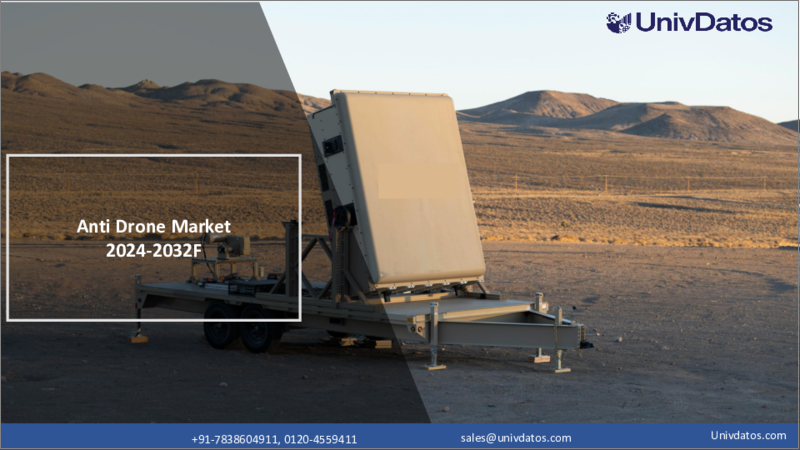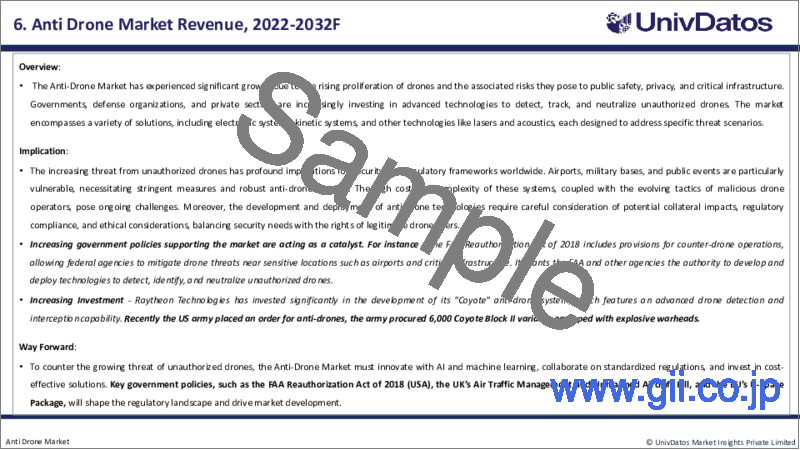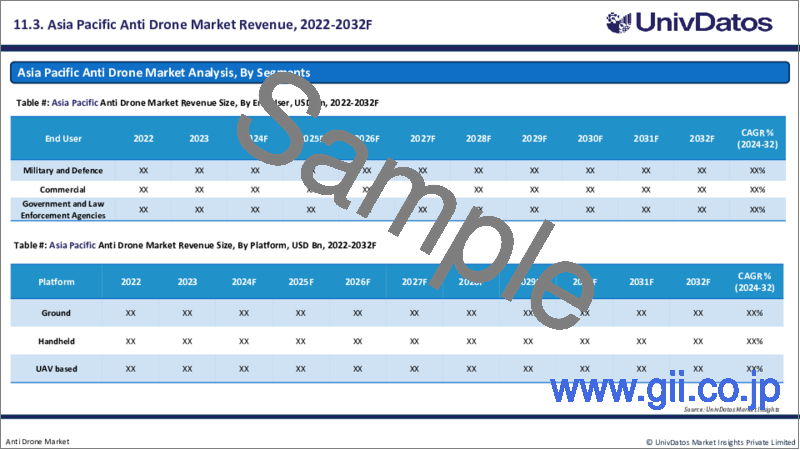|
|
市場調査レポート
商品コード
1429279
アンチドローンの世界市場:現状分析と予測(2023年~2030年)Anti-Drone Market: Current Analysis and Forecast (2023-2030) |
||||||
カスタマイズ可能
|
|||||||
| アンチドローンの世界市場:現状分析と予測(2023年~2030年) |
|
出版日: 2024年01月30日
発行: UnivDatos Market Insights Pvt Ltd
ページ情報: 英文 156 Pages
納期: 即日から翌営業日
|
- 全表示
- 概要
- 目次
アンチドローン市場は、市場における消費者向けドローンの容易な入手可能性と用途の拡大により、約11.71%の強力なCAGRで成長すると予想されています。さらに、消費者用ドローンは絶大な人気を得ており、さまざまな産業に革命をもたらし、世界中の想像力をかきたてています。しかし、こうした無人航空機(UAV)の普及に伴い、潜在的な脅威を軽減するための対策が急務となっています。その結果、アンチドローンシステムの市場は世界的に急成長を遂げています。ドローン愛好家の多くは責任を持って操縦していますが、消費者用ドローンの無許可使用は、プライバシー、セキュリティ侵害、重要な業務の妨害に対する懸念につながっています。空港付近でのドローンの目撃、無許可の撮影、密輸の試みなどの事件は、早急に対処すべき脆弱性を浮き彫りにしています。このような脅威から重要なインフラ、公共イベント、機密性の高いエリアを守るには、強固なアンチドローンシステムを導入する必要があります。例えば、2018年にロンドン・ガトウィック空港がドローンの活動により約1,000便のフライトを中断し、14万人以上の乗客に影響が出たという注目すべき出来事がありました。この33時間の混乱による経済損失は約5,580万ユーロと見積もられています。
技術別では、市場は電子システム、運動システム、その他に区分されます。これらのカテゴリーの中では、電子システムが最大のシェアを占めています。電子システムは、レーダー、無線周波数、赤外線などの様々な技術を利用し、レーダーシグネチャーに基づいてドローンを探知します。さらに、これらのシステムは、RFやGNSSジャミングのような技術を採用し、ドローンとそのオペレータ間の無線周波数接続を妨害したり、ドローンの衛星リンクを妨害したりすることで、未確認航空機がエリア内で活動することを禁止しています。電子システムの人気は、設置や使用が簡単なことに起因しており、その普及に大きく貢献しています。
用途別では、アンチドローン市場は検知と検知・妨害に二分されます。市場シェアでは、検知・妨害のアンチドローンシステムが市場を独占しています。その主な理由は、ドローンの脅威に対抗するための包括的なアプローチです。ドローンの存在のみを識別する検知のみのシステムとは異なり、検知・妨害システムは積極的に脅威を軽減する能力を備えています。これらのシステムは、無許可ドローンの効果的な無力化を保証する多層防御メカニズムを提供し、これらのような要因は、アンチドローンシステムの検知・妨害の人気がますます高まる上で極めて重要な役割を果たしています。
エンドユーザー別では、アンチドローン市場は軍事・防衛、商業、政府・法執行機関に区分されます。世界市場でアンチドローンシステムの最大需要を生み出しているのは商業セグメントです。空港付近でドローンが目撃されると、飛行業務に大きな支障が生じ、航空業界に数百万米ドルの損害を与えています。同様に、倉庫、建設現場、製造施設の近くに無許可でドローンが存在すると、物流業務に支障をきたし、生産性が低下する可能性があります。空港、スポーツスタジアム、コンサート会場、ショッピングモールなどの商業空間は、多くの観客を対象としています。悪意のあるドローンによる潜在的な脅威は、公共の安全を脅かし、業務を混乱させ、広範囲にパニックを引き起こす可能性があります。
市場は北米(米国、カナダ、その他)、欧州(ドイツ、英国、フランス、スペイン、イタリア、その他)、アジア太平洋(中国、日本、インド、その他)、世界のその他の地域に基づいて分析されています。北米はアンチドローン市場の大部分を占めており、予測される期間に大幅な成長を遂げると予測されています。北米では、インフラ、防衛、治安、大規模イベントなど、さまざまな分野でセキュリティが重視されています。このようなセキュリティへの関心の高まりは、ドローンが密輸、テロ、プライバシーの侵害などの違法行為に悪用される可能性があるという脅威の状況の変化への直接的な対応です。このようなリスクに対する認識の高まりが、重要なインフラを保護し、潜在的な脅威を軽減できるアンチドローンシステムの需要を後押ししています。さらに、北米の防衛・軍事部門は、ドローンの脅威に対抗することの重要性を認識しています。紛争中の非従来型戦争戦術におけるドローンの活用は、堅牢なアンチドローン技術の開発を必要としています。防衛機関は、自国の資産、部隊、国境を守るために、敵対的な無人航空機(UAV)を検出、追跡、無力化できるソリューションを積極的に模索しています。例えば、2022年4月、アメリカのアメンタムは、国土安全保障省(DHS)のために、C-UAS技術とシステムの実証と評価を行う2億6,000万米ドルの契約を獲得しました。これには、C-UAS関連のサイバー脆弱性、無線周波数スペクトル測定、さまざまなミッション分野にわたるプロトタイプC-UASシステムの統合と配備の分野における研究開発とテスト能力が含まれます。2023年~2028年に、約2億4,000万米ドルがこのプログラムに費やされる見込みです。
目次
第1章 市場イントロダクション
- 市場の定義
- 主な目標
- ステークホルダー
- 制限事項
第2章 調査手法または前提条件
- 調査プロセス
- 調査手法
- 回答者プロファイル
第3章 市場要約
第4章 エグゼクティブサマリー
第5章 COVID-19がアンチドローン市場に与える影響
第6章 アンチドローン市場の収益(2020年~2030年)
第7章 市場洞察:技術別
- 電子システム
- 運動システム
- その他
第8章 市場洞察:用途別
- 検知
- 検知・妨害
第9章 市場洞察:エンドユーザー別
- 軍事・防衛
- 商業・
- 政府・法執行機関
第10章 市場洞察:プラットフォーム別
- 地上
- ハンドヘルド
- UAVベース
第11章 市場洞察:地域別
- 北米
- 米国
- カナダ
- その他北米
- 欧州
- ドイツ
- 英国
- フランス
- イタリア
- ロシア
- その他欧州
- アジア太平洋
- 中国
- インド
- 日本
- 韓国
- その他アジア太平洋
- 世界のその他の地域
第12章 アンチドローン市場力学
- 市場促進要因
- 市場の課題
- 影響分析
第13章 アンチドローン市場機会
第14章 アンチドローン市場動向
第15章 需要側と供給側の分析
- 需要側分析
- 供給側分析
第16章 バリューチェーン分析
第17章 競合シナリオ
- 競合情勢
- ポーターのファイブフォース分析
第18章 企業プロファイル
- RTX
- Lockheed Martin Corporation
- Leonardo S.p.A.
- Thales
- IAI
- Rafael Advanced Defense Systems Ltd
- Blighter Surveillance Systems Limited
- DroneShield Ltd
- Dedrone
- DETECT, INC.,
第19章 免責事項
Anti-drone systems, also known as counter-drone systems or drone defense systems, refer to various technologies and techniques designed to detect, identify, track, and neutralize unauthorized or potentially dangerous unmanned aerial vehicles (UAVs), commonly known as drones. These systems are developed with the primary objective of safeguarding various critical infrastructures, sensitive areas, events, and military installations from potential threats posed by rogue drones. The anti-drone systems utilize a combination of advanced sensors, surveillance techniques, and countermeasures to effectively counteract the unauthorized or malicious use of drones.
The Anti Drone Market is expected to grow at a strong CAGR of around 11.71% owing to the easy availability and expanding use of consumer drones in the market. Furthermore, consumer drones have gained immense popularity, revolutionizing various industries and capturing imaginations worldwide. However, with the proliferation of these unmanned aerial vehicles (UAVs) comes the pressing need for countermeasures to mitigate potential threats. As a result, the market for anti-drone systems is experiencing tremendous growth globally. While most drone enthusiasts operate responsibly, the unauthorized use of consumer drones has led to concerns over privacy, security breaches, and disruption of critical operations. Incidents of drone sightings near airports, unauthorized photography, and smuggling attempts highlight the vulnerabilities that need to be addressed urgently. Protecting critical infrastructure, public events, and sensitive areas from such threats necessitates deploying robust anti-drone systems. For instance, a notable event occurred in 2018 when London Gatwick Airport experienced the disruption of approximately 1,000 flights due to drone activity, impacting over 140,000 passengers. The resulting economic loss from the 33-hour disruption was estimated at around EUR 55.8 million.
Based on technology, the market is segmented into electronic systems, kinetic systems, and others. Among these categories, the electronic system dominates the market with the largest share. The electronic system utilizes various technologies such as radar, radio frequency, and infrared to detect drones based on their radar signature. Additionally, these system employs technologies like RF and GNSS jamming to disrupt the radio frequency connection between the drone and its operator, or to interfere with the drone's satellite link, thereby prohibiting unidentified aircraft from operating in the area. The electronic systems' popularity stems from their ease of installation and use, greatly contributing to their widespread growth.
Based on application, the anti-drone market is bifurcated into detection and detection and disruption. The detection and disruption anti-drone system dominated the market in terms of market share. The primary reason behind the domination is their comprehensive approach to countering drone threats. Unlike detection-only systems, which solely identify the presence of drones, detection, and disruption systems are equipped with the ability to actively mitigate the threat. These systems offer a multi-layered defense mechanism that ensures the effective neutralization of unauthorized drones, and factors like these have played a pivotal role in the ever-increasing popularity of detection and disruption of anti-drone systems.
Based on end-users, the anti-drone market is segmented into military and defense, commercial, and government and law enforcement agencies. The commercial segment generates the maximum demand for anti-drone systems in the global market. Drone sightings near airports have led to significant disruptions in flight operations, costing the aviation industry millions of dollars. Similarly, unauthorized drone presence near warehouses, construction sites, or manufacturing facilities can disrupt logistical operations and hamper productivity. Commercial spaces, such as airports, sports stadiums, concert venues, and shopping malls, cater to a vast audience. The potential threat of malicious drone activities jeopardizes public safety and can disrupt operations, causing widespread panic.
For a better understanding of the market adoption of white goods, the market is analyzed based on its worldwide presence in countries such as North America (The U.S., Canada, and the Rest of North America), Europe (Germany, The U.K., France, Spain, Italy, Rest of Europe), Asia-Pacific (China, Japan, India, Rest of Asia-Pacific), Rest of World. North America holds a significant portion of the anti-drone market and is projected to experience substantial growth in the predicted timeframe. Security is given great importance in various sectors within North America, including infrastructure, defense, public safety, and large-scale events. This heightened focus on security is a direct response to the changing threat landscape, where drones can be exploited for illegal activities, such as smuggling, terrorism, and invasion of privacy. The increasing recognition of these risks has driven the demand for anti-drone systems that can safeguard critical infrastructure and mitigate potential threats. Moreover, the defense and military sectors in North America have acknowledged the significance of countering drone threats. The utilization of drones in unconventional warfare tactics during conflicts has necessitated the development of robust anti-drone technologies. Defense agencies are actively searching for solutions that can detect, track, and neutralize hostile unmanned aerial vehicles (UAVs) to safeguard their assets, troops, and borders. For instance, In April 2022, American company Amentum was awarded a USD 260 million contract to demonstrate and evaluate C-UAS technologies and systems, for the Department of Homeland Security (DHS). This includes R&D and testing capabilities in the areas of C-UAS-related cyber vulnerabilities, radio frequency spectrum measurements, and integration and deployment of prototype C-UAS systems across various mission areas. Around USD 240 million is expected to be spent on this program over the period 2023-2028.
Some of the major players operating in the market include RTX; Lockheed Martin Corporation; Leonardo S.p.A.; Thales; IAI; Rafael Advanced Defense Systems Ltd; Blighter Surveillance Systems Limited; DroneShield Ltd; Dedrone; and DETECT, INC.,
TABLE OF CONTENTS
1 MARKET INTRODUCTION
- 1.1. Market Definitions
- 1.2. Main Objective
- 1.3. Stakeholders
- 1.4. Limitation
2 RESEARCH METHODOLOGY OR ASSUMPTION
- 2.1. Research Process of the Anti-Drone Market
- 2.2. Research Methodology of the Anti-Drone Market
- 2.3. Respondent Profile
3 MARKET SYNOPSIS
4 EXECUTIVE SUMMARY
5 IMPACT OF COVID-19 ON THE ANTI-DRONE MARKET
6 ANTI DRONE MARKET REVENUE (USD BN), 2020-2030F
7 MARKET INSIGHTS BY TECHNOLOGY
- 7.1. Electronic System
- 7.2. Kinetic System
- 7.3. Others
8 MARKET INSIGHTS BY APPLICATION
- 8.1. Detection
- 8.2. Detection and Disruption
9 MARKET INSIGHTS BY END-USER
- 9.1. Military and Defence
- 9.2. Commercial
- 9.3. Government and Law Enforcement Agencies
10 MARKET INSIGHTS BY PLATFORM
- 10.1. Ground
- 10.2. Handheld
- 10.3. UAV based.
11 MARKET INSIGHTS BY REGION
- 11.1. North America
- 11.1.1. The U.S.
- 11.1.2. Canada
- 11.1.3. Rest of North America
- 11.2. Europe
- 11.2.1. Germany
- 11.2.2. The U.K.
- 11.2.3. France
- 11.2.4. Italy
- 11.2.5. Russia
- 11.2.6. Rest of Europe
- 11.3. Asia-Pacific
- 11.3.1. China
- 11.3.2. India
- 11.3.3. Japan
- 11.3.4. South Korea
- 11.3.5. Rest of Asia-Pacific
- 11.4. Rest of the World
12 ANTI-DRONE MARKET DYNAMICS
- 12.1. Market Drivers
- 12.2. Market Challenges
- 12.3. Impact Analysis
13 ANTI-DRONE MARKET OPPORTUNITIES
14 ANTI-DRONE MARKET TRENDS
15 DEMAND AND SUPPLY-SIDE ANALYSIS
- 15.1. Demand Side Analysis
- 15.2. Supply Side Analysis
16 VALUE CHAIN ANALYSIS
17 COMPETITIVE SCENARIO
- 17.1. Competitive Landscape
- 17.1.1. Porters Fiver Forces Analysis
18 COMPANY PROFILED
- 18.1. RTX
- 18.2. Lockheed Martin Corporation
- 18.3. Leonardo S.p.A.
- 18.4. Thales
- 18.5. IAI
- 18.6. Rafael Advanced Defense Systems Ltd
- 18.7. Blighter Surveillance Systems Limited
- 18.8. DroneShield Ltd
- 18.9. Dedrone
- 18.10. DETECT, INC.,





